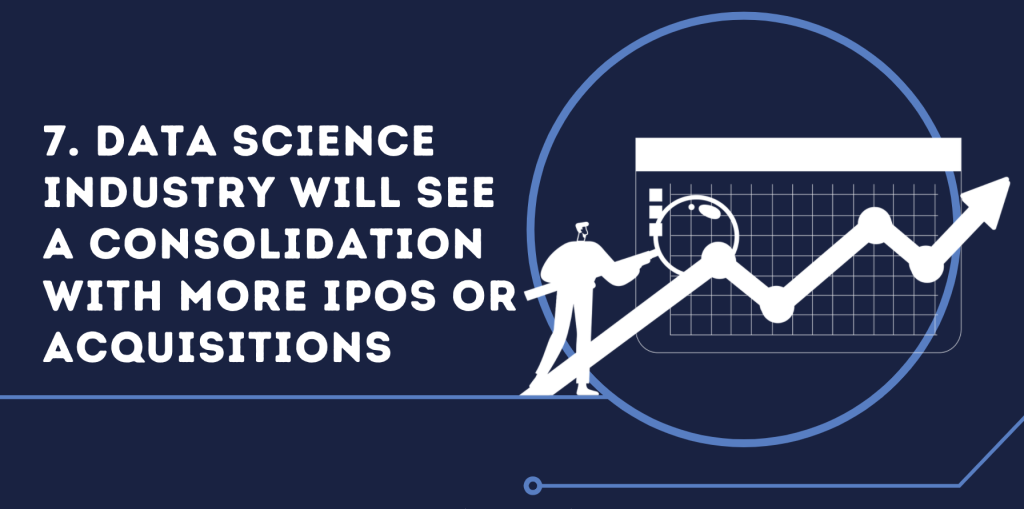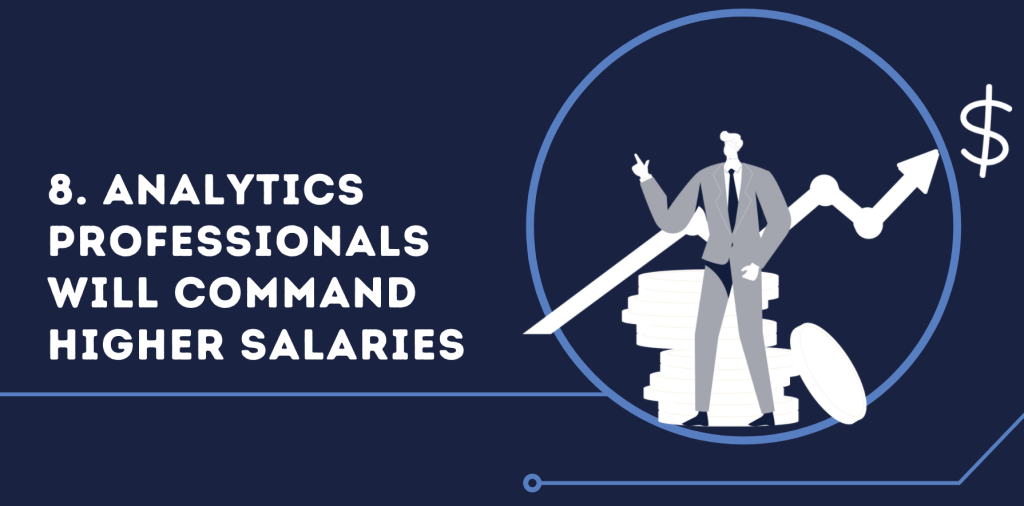After a pandemic-driven start to 2020, enterprises across industries realised the significance of AI and Data Sciences. Its adoption accelerated, and leaders correctly predicted growth in the industry in all aspects. Overall, organisations invested more in Data Science, and there was an upswing in the Data Science jobs. While the median salaries of analytics professionals saw a slight decline at the start of the year, a rising trend was witnessed again in the recent months, which will continue to be the case in the coming year. The inefficiencies of Data Science teams from development to deployment in the real world were observed before but they became even more evident due to the pandemic. The operationalisation and scaling of Machine Learning models through structured frameworks was the talk of 2021. These processes will start getting streamlined in the coming years.
The Data Science industry also realised the breadth of roles needed for these deployments. While generalists will continue to be in demand, niche roles will play an important role going forward, especially Data Engineers. Subsequently, the role of education will also evolve. It will become further formalised with more specialisation courses introduced. First, they will be introduced as certification courses and then as undergraduate or postgraduate programmes. Data Engineers will also play an important role in establishing data management architectures as companies look to democratise data access and establish efficient pipelines. Organisations will redefine their data strategies according to these processes. Large language models will become huge, and new age algorithms will be used even by smaller companies.
Finally, this year was marred with controversies surrounding Big Tech and the use of biased or unethical algorithms. The impact of AI/ML algorithms on society and individuals is becoming apparent, and the accountability of organisations building them is increasing. While organisations in the Western world have realised this and started taking steps, the field of Ethical or Responsible AI is still at a very early stage in India. This will change in 2022. Companies will actively hire AI Ethicists, and third-party auditing will become a part of the modelling process. Finally, leaders have also realised the importance of localising AI/ML. Training models on local data will not only give better business results but also provide better accuracy. This will play an important role in improving customer engagement.
The annual data science and AI trends report by Analytics India Magazine aims to highlight the top trends that will define the industry each year. This report, which has been developed in association with T. A. Pai Management Institute (TAPMI), covers the trends that will shape the year 2022.

Access reports from the previous years below:

Around 72% of organisations that began AI pilots couldn’t deploy even a single application in production, according to a 2019 Capgemini report. Similarly, a 2020 survey showed that around 55% of the companies actively engaging in Machine Learning had not deployed a single model. While many data scientists build machine learning models, they lack engineering knowledge leaving a glaring gap between development and deployment. MLOps brings Data Scientists and IT Engineers/developers together to deploy ML models faster and at scale.
IT Engineers have been using DevOps for years now. DevOps is a set of practices and tools that increase the organisation’s ability to deploy applications in the real world. MLOps builds on DevOps ideas to facilitate the automated development and deployment of machine learning models and applications. MLOps observes growing importance among Data Science or AI leaders, who have realised the limitations of data scientists to be good programmers.
While MLOps as a term was coined in 2015, it has gained traction in recent years.
The rising significance of Data Science and the need for automation (especially after the pandemic) got leaders talking about the topic more. AI leaders predict a growing focus on MLOps in 2022. Its use will be streamlined and decide investment in ML models. Furthermore, the gap between Data Science and Engineering will narrow.

“We will increasingly see maturity in systems where AI and Engineering elements are built to allow easily scalable, automated and “low-touch” operations. The field of MLOps will allow for easier and faster scalability to AI/ML operations, and we will see increasing use of ‘AutoML’ tools that will make the process of building AI models easier.”
Suraj Amonkar, VP – AI@scale at Fractal Analytics

“AI/ML Ops will gain a lot of traction due to demand for faster experimentation and execution of AI/ML models at scale owing to the phase where a lot of prototypes envisage production. Along with it, AI/ML on cloud and low code AI will become more prominent.”
Ruble Joseph, VP – Data Science and Analytics at eClerx

Analytics India Magazine conducted a survey in April to analyse the state of Responsible AI in India. It was observed that while some Indian enterprises are making an effort in adopting guidelines or frameworks, they are still behind when it comes to conducting third-party audits or impact assessments.
Around a third (33%) of the companies do not have any internal risk evaluation or auditing frameworks, and only 7% of firms had adopted third-party auditors.
In addition, only a quarter of them (28%) have bias detection frameworks.
Leaders predict that Ethical AI frameworks will play a significant role in 2022, with audits becoming a part of modelling cycles. Considering how Big Tech has been held accountable for their biased AI algorithms, we will see an increased focus on the responsible and ethical development of AI/ML.
Beyond the ML model’s decision-making, the ethicality tests will also extend to privacy. These will be subject to the data privacy bills introduced by the Indian government. Companies will start standardising processes for the same, which will play a significant role in the organisation’s data strategy.

“Until now, organizations across industries have been the hyper-focused on model building and model performance. However, as the adoption and reliance on AI and automated decision making continue to grow exponentially, trust becomes a very important factor and the need for explainable AI or FATE (fair, accountable, transparent, ethical) AI will slowly gain momentum. In 2022 and beyond, as AI moves into the real world, enterprises as well as regulators would be keenly looking at incorporating the ability to explain the decision-making process involved in AI/ML algorithms deployed in critical areas.”
Kunal Aman, Head – Marketing & Communications at SAS

As organisations scale up on their AI adoption journey and data privacy issues gain prominence, Data Governance will become the foundational pillar of an organisation’s data strategy. In simplest terms, data governance is about managing data as a strategic asset and democratising data responsibly.
Rohini Srivathsa, National Technology Officer at Microsoft

The annual salary study conducted by AIM Research in June 2021 showed that Data Engineers commanded a median salary greater than Big Data Scientists or AI Engineers. This is indicative of the increase in demand for these professionals but a lack in supply. Data Engineers are analytics professionals responsible for generating, cleaning, processing, and storing data in a way that is ready for analysis.
Data Engineers lay the foundation for Data Scientists or AI/ML professionals to do their jobs.
With the increase in digital transformation after the pandemic and the ability to collect data from various sources and formats, data engineering will play an important role. The industry already faces challenges in hiring Data Science talent. In addition, the dearth of data engineers will be felt even more in 2022.

“The pace of digital transformation, post-pandemic, has increased the demand for data engineering capabilities manifold. Most newer projects focus on creating a robust data layer before applying sophisticated machine and deep learning algorithms. In addition, the explosion of data itself, the need for more quality and comprehensive data, as well as increasing cloud capabilities are adding fuel to the growing traction of data engineering skillset, which is now being rightly termed as the sexiest job of the current times.”
Swati Jain, VP Analytics at EXL

“With an increase in the volume and sources of data and the continuous evolution of data processing platforms like the cloud, the task of Data Engineering is becoming crucial & challenging by the day. With Data Engineering quickly becoming the nerve centre of Digital Strategy, organisations are finding it challenging to align themselves and build teams of Data Engineering Talent. As of 2021, LinkedIn is showing more than 29K job opportunities in data engineering as organisations still face a significant shortage with not enough data engineering talent in the market. As the range of skills entailing Data Engineering spans 15-25 technologies, hence building an integrated multi-disciplinary team is the key to success.”
Sriram Narasimhan, Head of Data, Analytics and AI at Cognizant

GPT-3 made a lot of fuss in 2020 when it published an article in The Guardian. However, its methodology made the model’s shortcomings very apparent, and it was written off by many leaders in the industry. In all, experts have divided opinions on the subject. While some have expressed surprise over the rapid progress various language models have made, others see significant limitations.
One thing is sure that as language models grow, their capabilities change in unexpected ways. For example, the GPT-3 model had 175-billion parameters, 100 times more than GPT-2. These parameters have now reached trillions, with Google releasing GLaM trained on 1.2 trillion parameters and DeepMind released Gopher trained on 280 billion dollars in 2021.
Along with the number of parameters, newer models also are seeing improvement in computation efficiency and training text.
The importance of language models is growing significantly. This is especially true in the post-pandemic world, where conversational AI plays a big role in customer engagement. With more accuracy, the models will achieve several tasks like writing articles, synthesising reports, searching, and code generation. Leaders believe that we will see many enterprises in the industry next year focusing on solving pertinent challenges in the area.

“Large language models (LLM) will fuel the next wave of automation. Arguably LLMs could be very close to the AGI or artificial general intelligence. There are many organisational tasks, business processes that still rely on the human ability of language and technical writing skills. Even in the media industry, for content repurposing there is great demand for automation of tasks for subtitle generation, creating storylines, publishing in multiple languages simultaneous. LLMs can bring more than 90% of automation in each case. The LLMs are not just about language alone. It learns from image, video and thus in the true sense bridge the context gap which is usually one of the major drawbacks of other types of models. This multimodality is one of the key improvements and will be found generally useful for the usage of LLMs.”
Biswajit Biswas, Chief Data Scientist at Tata Elxsi

“2021 observed a growing increase in the use of natural language for routine analysis to detect trends, multilingual language construct and sentiment in data. These have downstream use cases in providing seamless multilingual experiences in chat, search, coding, media, even literature and art. This is in part fuelled by the ever-expanding penetration of technology worldwide. Both these trends will continue to intensify in 2022 with increased requirements for multilingual processing. An example of how this technology can evolve is Open AI’s GPT-3. While garnering mixed opinions and still a long way to go, it has shown capabilities in creating human-like language in code, conversations etc. GPT-4 is expected to incorporate text and visual patterns to improve this.”
Vanitha D’Silva, Director Data Science at Skoruz Technologies

As Data Science becomes more ubiquitous across industries, the demand for data science talent will grow further. Today, the lack of data science talent is probably the most pressing concern the industry faces in India.
While the subject needs continuous upskilling, formal education will play a big role in addressing this talent gap.
Private and public institutions have realised this and have introduced newer courses. These courses go beyond introducing specialisation modules in an existing course and moving to full-fledged undergraduate and postgraduate programmes. Just this year, AIM’s academic rankings got nominations of more than ten different postgraduate and undergraduate programmes that are running their first batches.
These courses will also get more specialised. Industry leaders realise the breadth of data science roles and the importance of fulfilling the positions through the analytics pipeline. As the demand for specialised professionals like data engineers, NLP engineers, Computer Vision, etc., increases, more courses specific to the subject areas will be introduced.

“Data Science education has become more formalised, and it will continue to do so. When I started work, there were no courses in data science. People from statistics, econometrics, computer science or even business got together to create the discipline. Now that has changed, and as the discipline gets more structured, we will see even more structured courses, both broader ‘end-to-end’ ones and new niche areas. I also think for niche courses it will be a demand-pull process where corporate clients would be the first ones to reach out to institutions to ask for very specific areas to upskill their talent. I have seen this earlier for HR analytics, supply chain, healthcare analytics, etc. Eventually, as the broader mandate picks up, these courses become a mass market. I predict that will be happening next in Cloud-Based AI, IoT and Edge, AI/ML in Cybersecurity or Fintech among others.”
Dipyaman Sanyal, Academic Head at Hero Vired

“Three things are likely to happen: 1. Data Science education will become mainstream in undergraduate engineering and science colleges in the form of BSc/ B.Tech/ BE in Data Science. 2. As the area matures, institutes will offer sharper specialisations ranging from Data Management and Business Intelligence to Data Engineering, Machine Learning Engineering and Data Visualisation (and several others). 3. Domain-specific Data Science will gain currency, especially for mid-level managers, and there will be industry-academia partnerships to develop Data Science courses customised for domains like supply-chain, retail, health, agriculture, finance, marketing, telecom, manufacturing etc.”
Charanpreet singh, founder & Director at Praxis Business School Foundation

IBM defines data fabrics as a data management architecture that can optimise access to distributed data and intelligently curate and orchestrate it for self-service delivery to data consumers. The idea is to ensure data access to all the right stakeholders irrespective of where it is generated or stored. It is a powerful architecture that standardises data management practices across cloud, on-premises, and edge devices.
This can help in effective and sustainable digital transformation and improve the value of data within the organisation while also reducing costs.
Along with data access and control, it also addresses concerns related to data governance and security.
The increasing ability of AI applications to tightly integrate with the hardware and operate intelligently on their own will facilitate the formation of robust data fabrics. Intelligent edge devices will play an important role in data fabrics that will help save bandwidth, reduce latency, and further improve privacy and security.

“Data fabrics have emerged as the key element to designing a successful enterprise data strategy. They serve integrated layers of data connecting processes and distributing valuable insights across operations, users, and platforms. In addition, Artificial Intelligence technologies within the data fabric will dramatically improve enterprises’ return on investment, while significantly reducing operational costs.”
Sreekanth Menon, VP – Data Science at Genpact

“One of the biggest game-changer will be ‘Edge Computing’. This will enable companies to store, access and retrieve AI-based data storage to remain local rather than keep it remote in the cloud. This will enable quick and faster decision making. Thus AI will help companies make decisions, take actions and switch strategies in real-time.”
Pradeep Mishra, Sr. Vice President at VECV

India has enlisted 55 companies in 2021 (until Dec 15), raising over 1.2 lakh crores. This is 4.5 times more than the number of companies listed and 3.2 times more than the money issued through IPOs in 2020. In addition, several more companies are in the pipeline for the coming year. Many of these IPOs are new-age companies that are predominantly tech-based and leverage AI and Data Science. Some of the names include Zomato, PayTM, and PolicyBazaar. While several factors contribute to the increase of the overall IPOs, the Private Equity/Venture Capitalist investment cycle of Data Science or Tech companies gives it a further boost.
This is reflected in the over-subscription of LatentView IPO. India saw the first pure-play analytics company listed in the year, paving the way for others.
The number of acquisitions in India also increased significantly. In August, India completed 155 acquisitions – this is more than the total number of acquisitions in 2020. Large companies are looking to buy startups to make way for themselves in the digital economy. A significant investment in the tech startups, along with the agile model that they are set up in, makes it easy for bigger companies to acquire them. Niche AI/ML companies are solving complex problems with great accuracy. Bigger companies see this as an opportunity to improve their technical capabilities, while smaller companies see this as an avenue to improve their market penetration.

“The data science and analytics industry has been experiencing tremendous growth. This growth is just the early stages of a deep, long-term change that was set into motion by the shift to digital, and further accelerated by the pandemic. Analytics has proven to be a ‘must-have’ capability for businesses to succeed and thrive. So, it comes as no surprise that the past two years have ushered in a number of acquisitions. More recently, the successful launch of India’s first analytics IPO is another positive indicator of the tremendous potential of the analytics industry ahead. I believe we can expect to see many such strategic investments in the years to come and look forward to accelerating our momentum.”
Sunil Mirani, Co-founder & Chief Executive Officer at Ugam

“IPOs and acquisitions are force multipliers if done rightly. Think of it as a virtuous cycle. It can have a huge impact across the enterprise value, including employees, clients, suppliers, investors, and partners. As IPO markets gain momentum, data science companies are enjoying favourable market sentiment, high liquidity in the financial system and rising investments in analytics. On one hand, large enterprises are acquiring mature analytics practices to attain speed for innovation. On the other, analytics vendors themselves are racing to differentiate by consolidating capabilities. Companies focusing on building and acquiring customer-centric capabilities will survive to enjoy market dominance in the next stage.”
Shashank Dubey, Co-founder & Chief Revenue Officer at Tredence

The scale of growth of any domain is evinced by the salaries drawn by experienced professionals or the growth in the proportion of experienced professionals drawing higher salaries. In addition, the pandemic accelerated the need for data-driven decision-making and intelligent automation, increasing the demand for data scientists.
According to the salary report published by AIM Research in June 2021, the median salary slightly declined compared to 2021 from 14.4 lakhs to 13.4 lakhs (still higher than the 2019 median of 12.6 lakhs).
However, a recent analysis in AIM showed that the salaries are again seeing an upward trend with the median salary for data scientists at 13. 6 lakhs in August 2021. This trend will continue in the coming year.
The supply-demand gap and need for niche technical skills will lead to analytics professionals commanding more salaries in the coming year.

“The current talent scarcity will contribute to leaps in salary benchmarks for analytics professionals. However, there are two factors complicating this phenomenon: a growing scarcity of skilled professionals, despite the high demand for analytics professionals, as well as an emerging trend where professionals are waiting and making conscious choices to join growing unicorns rather than established organisations. Given these various factors, nurturing talent rather than relying on existing talent becomes essential for organisations to ensure a balanced and diverse workforce. Investing significantly in training/upskilling programs, and even infusing professional L&D programs right down into academic curricula themselves, will help encourage a new generation of skilled, resourceful, and future-ready experts.”
Sayandeb Banerjee, Co-Founder and CEO at TheMathCompany

“With multiple use cases across industries, the need for quality data analysis is ever-increasing. Professionals in the data science domain leverage their skills for complex functions, which help businesses and other organisations make informed decisions for better economic and social outcomes. Combining the current demand-supply dynamics, where there is a genuine need for analysts and data scientists, and the aforementioned need for technical skills, one can clearly foresee the rise in the remuneration of this sort of talent in India.”
Shashank Randev, Founder VC at 100X.VC

Federated machine learning is an ML technique that can train an algorithm across multiple decentralised edge devices. While the importance of intelligent edge devices has already been established, the significant rise in data breaches coupled with stringent data privacy laws will see a rising demand for federated learning.
Reinforcement Learning techniques have significantly outperformed previous ML algorithms, but the implementation is resource-intensive and costly.
Also, they are extremely sensitive to hyper-parameters. However, its implementation on the cloud has proven to be beneficial in several ways. Firstly, the pay-as-you-go model makes it significantly cheaper to train the models and secondly, you also benefit from better control on hyper-parameters.
Until now, the likes of FL and RL were only implemented by the big tech companies. Going forward, we will see even smaller data science organisations using them. The lowered cost and the privacy demands, along with the overall advancement in the research of these techniques, will drive this adoption.

“As lockdowns became the new normal, businesses and consumers increasingly ‘went digital’, providing and purchasing more goods and services online. With changing trends of customer behaviour, the business and models could no longer rely only on historical data. Hence RL algorithms are becoming increasingly famous to build dynamic systems with adjustments for uncertainties. With the increase in cloud-based frameworks and lower technological costs, smaller and bigger firms alike are rushing to use the power of RL. Several reports by Mckinsey, HBR and IDC state that RL is the next big thing, and by 2022 – one in six customer experience applications will use RL. On the other hand, with the exponential increase in consumer data, the risks associated with data privacy also increased manifold. Several data breaches over the past years have nudged developers towards techniques like FL that ensures data privacy along with collaborative learning, especially in the post-pandemic digital world.”
Anirban Nandi, Vice President, Data Sciences & Analytics at Rakuten

“Deepfakes are great examples of synthetic data. The use of deepfakes for deceptive purposes (political, religious) has caused some disrepute to the field of deep learning. More tools will become available for businesses and entities to identify and cull out deceptive use of deep fakes. In parallel, the field of synthetic data (images, voices, data) will see increased investments given the ability of well crafted synthetic to help in training models that have otherwise been languishing due to lack of good data.”
Subramanian M S, Head of Category Marketing and Analytics at Bigbasket

AI has primarily grown in English-speaking countries, and ML models have been trained on data in those countries. This makes algorithms less accurate when they function in other countries, especially when it comes to language models. On the other hand, localising content delivers substantial business benefits and improved customer engagement. Indian leaders have realised the importance of adopting AI to local parameters.
Through AI localisation, people train AI engines with hyperlocal content and in-market user experiences-generated data.
There will be increased importance to the localisation for language translation and curating accurate ML predictions in the Indian context. Beyond data, artificial intelligence and human intelligence will have to work closely together to observe improved results.

“Vernacularisation & localisation need to proliferate more. Speaking in the local language and the ‘Bharat’ segment is another big step. AI has been primarily grown in the US market with the English language. Adopting AI to recognise vernacular languages and the vernacular settings in developing market is essential for us to move further.”
Mathangi Sri, VP Data Science at Gojek

Ankush Sabharwal, Founder & CEO at CoRover
“Switching between languages involves more than just exact translation. There is a need to understand the context and specific language differences to provide a properly adapted chatbot version. The foundation to achieve such seamless translation lies in how strong the knowledge base is. A strong chatbot program is built on a knowledge base that consists of primary data, facts, assumptions, and the rules of the system available to solve a problem. The chatbot’s ability to connect and interact with the customer is dependent on how well-built and expansive this knowledge base is.”


























